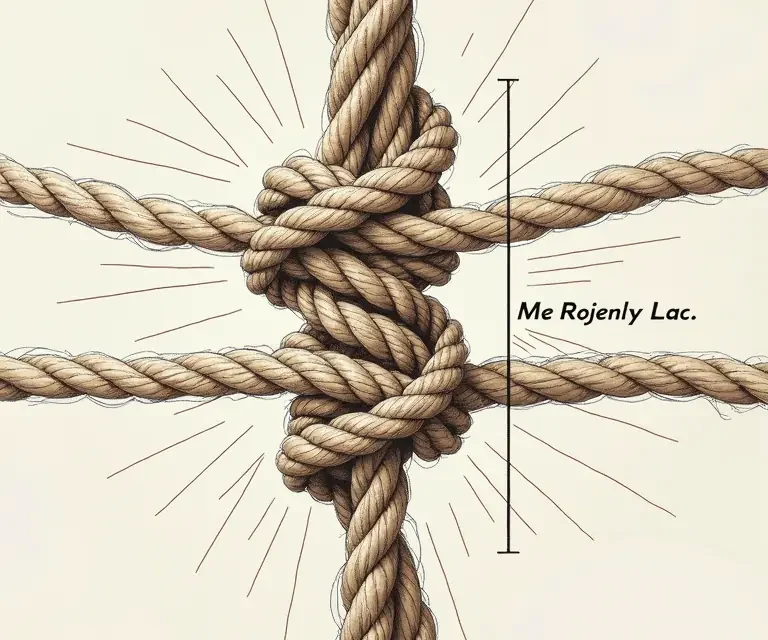Knots. We use them daily, often without a second thought. Tying our shoelaces, securing a package, mooring a boat – knots are fundamental to human endeavor. But beneath the seemingly simple act of looping and tightening lies a surprisingly consistent and deeply studied science. From the earliest sailors relying on hemp rope to modern engineers utilizing high-tech fibers, understanding knot strength has always been crucial. This article will explore the fascinating history and scientific principles behind how knots hold, break, and evolve, and how remarkably consistent those principles have been across materials and time.
A History Woven in Rope: Ancient Origins and Practical Necessity
The history of knots is inextricably linked to the history of civilization. Archaeological evidence suggests that humans have been tying knots for tens of thousands of years. The oldest known example of knotted objects, discovered in a German cave, dates back roughly 40,000 years. While their exact purpose remains debated – potentially for record-keeping, clothing fasteners, or even symbolic meaning – they demonstrate an early understanding of manipulating fibers.
The practical necessity of knots became paramount with the development of sailing. Ancient Egyptians, Phoenicians, and Greeks relied heavily on ropes and knots for shipbuilding, navigation, and trade. The knowledge of knot tying was a closely guarded skill, passed down through generations of sailors. Many of the knots we still use today – the sheet bend, clove hitch, and bowline – have roots in these ancient maritime traditions. These early sailors weren’t just using knots; they were observing how different weaves responded to strain, effectively conducting early, empirical material science.
Beyond seafaring, knots played a vital role in countless other applications: hunting (snares and traps), construction (securing structures), and everyday life (clothing, tools). The development of specialized knots for specific purposes demonstrates an increasing understanding of the relationship between knot structure, material properties, and load-bearing capacity.
The Mechanics of a Knot: Why Do They Hold?
At a fundamental level, a knot’s strength depends on how effectively it distributes stress throughout the rope or cord. When a force is applied to a rope, the fibers within experience tension. A well-tied knot minimizes stress concentrations – points where the tension is excessively focused – and maximizes the number of fibers contributing to the load-bearing capacity. Conversely, a poorly tied knot creates sharp bends and friction points, leading to stress concentrations and premature failure.
Several key factors influence a knot’s strength:
- Rope Material: The strength and elasticity of the rope material are paramount. Natural fibers like hemp and cotton have lower tensile strength than synthetic fibers like nylon and polyester.
- Knot Geometry: The shape and arrangement of the knot significantly affect its ability to distribute stress. Some knots, like the bowline, are inherently stronger because they maintain a larger proportion of the rope’s original strength.
- Tightness: A properly tightened knot is crucial. Loose knots create slack and allow for slippage, reducing strength.
- Loading Type: The way a load is applied – tensile (pulling), compressive (squeezing), or bending – affects how the knot responds. Knots are generally strongest under tensile load.
The efficiency of a knot is often expressed as a percentage, representing the ratio of the knot’s breaking strength to the breaking strength of the untied rope. A knot with 60% efficiency means it will break when subjected to 60% of the force that would break the rope itself. The bowline, often lauded for its strength and ease of tying, typically has an efficiency of around 60-70%, depending on the rope material and tying technique.
The Mathematics of Knots: From Topology to Fracture Mechanics
While early understanding of knot strength was largely empirical, the advent of mathematics provided a more rigorous framework for analyzing knot behavior. Topology, a branch of mathematics dealing with the properties of shapes that are preserved under continuous deformations (stretching, bending, twisting), offers insights into the fundamental properties of knots. Topological invariants – characteristics that remain constant regardless of how a knot is deformed – can be used to classify and compare different knot structures.
However, topology alone doesn’t explain knot strength. Fracture mechanics, which studies the propagation of cracks and failure in materials, provides a more direct link to practical applications. Understanding how stress concentrates at the knot’s bends and how those concentrations initiate cracks is critical for predicting knot failure. Finite element analysis (FEA), a computational technique used to simulate the behavior of complex structures, is now routinely used to model knot stress distributions and optimize knot designs.
Material Matters: The Evolution of Rope and Knot Strength
Throughout history, the materials used for rope have dramatically impacted knot strength and reliability. Natural fibers, while readily available, suffer from limitations: susceptibility to rot, moisture absorption, and relatively low tensile strength. The development of synthetic fibers in the 20th century revolutionized rope manufacturing.
Nylon, first synthesized in the 1930s, offered significantly higher tensile strength, elasticity, and resistance to abrasion compared to natural fibers. It quickly became the standard for many applications, including sailing, climbing, and industrial rigging. Polyester, developed later, offered even greater resistance to UV degradation and stretching, making it ideal for outdoor applications. More recently, ultra-high-molecular-weight polyethylene (UHMWPE) fibers, like Dyneema and Spectra, have emerged as the strongest commercially available fibers, boasting tensile strengths several times greater than steel.

However, simply using stronger materials doesn’t automatically translate to stronger knots. The interaction between the knot structure and the material properties is crucial. For instance, a knot that works well with a highly elastic material like nylon might perform poorly with a stiffer material like UHMWPE. The increased strength of modern fibers also demands more sophisticated knot tying techniques to avoid exceeding the knot’s limitations.
Testing Knot Strength: From Pulling Machines to Digital Simulations
Determining the actual strength of a knot requires rigorous testing. Historically, this involved manually pulling on knots until they broke, a laborious and often imprecise process. The development of universal testing machines, capable of applying controlled tensile forces, provided a more accurate and repeatable method. These machines allow researchers to measure the breaking strength of knots made with different materials and tying techniques.
Modern testing methods extend beyond simple tensile tests. Dynamic load testing simulates the forces experienced by knots in real-world applications, such as shock loading during climbing or wave action on a ship. Cyclic loading tests assess the knot’s resistance to fatigue – its ability to withstand repeated stress cycles. Microscopic analysis of broken knots reveals the failure mechanisms, providing insights into how to improve knot design and material selection.
The Art of Victorian Hairwork: A Consistent Application of Knotting (and Memory)
The principles of knot strength and material science, while not explicitly understood at the time, are demonstrably present in the intricate craft of Victorian hairwork. Popularized during the Victorian era as a means of mourning and remembrance, hairwork involved creating elaborate jewelry, wreaths, and keepsakes from human hair. The durability of these pieces, lasting for generations, relies on the careful selection of hair (a surprisingly strong natural fiber) and the precise application of knotting techniques. The consistency of these techniques, passed down through families and workshops, speaks to an intuitive understanding of how to create secure and lasting bonds. You can learn more about this fascinating craft here.
Beyond Strength: Specialized Knots and Emerging Applications
While maximizing strength remains a primary concern, many specialized knots are designed for specific purposes. Friction knots, like the prusik knot, are used for ascending ropes in climbing. Binding knots, like the square knot, are used for joining two ropes together. Decorative knots, like the Turk’s head, are prized for their aesthetic appeal.
The science of knots is also finding applications in emerging fields. Researchers are exploring the use of knot-inspired structures in materials science to create new materials with enhanced properties, such as improved toughness and flexibility. Knot theory is even being applied to problems in DNA biology, where DNA molecules often become knotted and tangled.
Consistency Across Disciplines: A Universal Principle
What’s truly remarkable about the science of knot strength is its consistency across disciplines. The same fundamental principles govern the behavior of a knot whether it’s securing a sailing ship, tying a climbing rope, or creating a Victorian hairwork memorial. The underlying physics – stress distribution, material properties, and failure mechanisms – remain constant, regardless of the scale or application. This echoes the consistent scientific principles seen in other natural phenomena, such as bird migration, or the predictable behavior of candle flames.
Furthermore, even the seemingly arbitrary naming conventions of everyday items, like food, demonstrate a surprisingly consistent etymological history, highlighting a broader pattern of consistent underlying principles in diverse fields.
The Future of Knot Science
The study of knot strength is far from complete. Ongoing research focuses on developing new materials with even greater strength and durability, optimizing knot designs for specific applications, and improving our understanding of failure mechanisms. Advances in computational modeling and machine learning are enabling researchers to simulate knot behavior with unprecedented accuracy and to explore new knot designs that were previously unimaginable.
As we continue to push the boundaries of materials science and engineering, the seemingly simple act of tying a knot will remain a testament to human ingenuity and the power of scientific understanding. Understanding the subconscious processes behind even seemingly abstract activities, like dream interpretation, also reveals consistent patterns and underlying principles. The science of knots, therefore, isn’t just about ropes and fibers; it’s about a fundamental understanding of how things hold together – both literally and figuratively.


 The Surprisingly Durable Legacy of Ancient Roman Concrete
The Surprisingly Durable Legacy of Ancient Roman Concrete